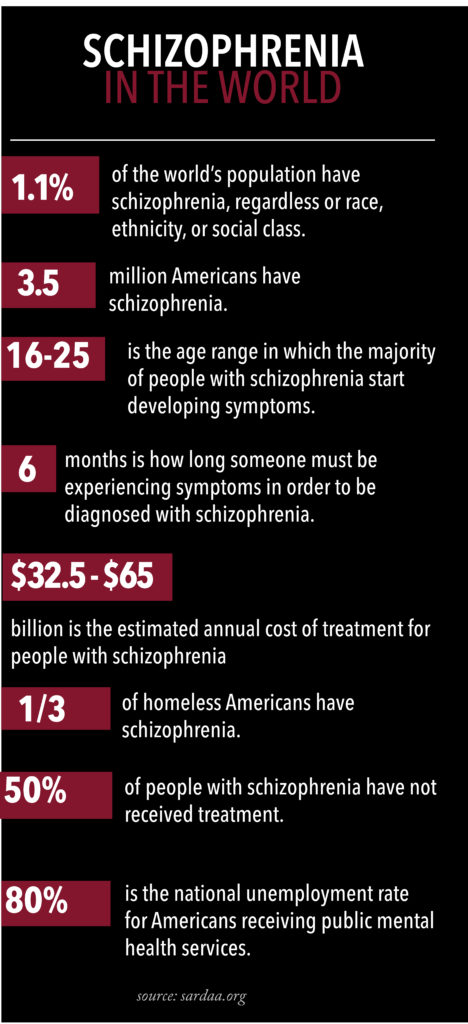Mikael Rehman has spent years learning how to reduce stress, deal with his hallucinations, and be happy with his schizophrenia.
Taking a walk has always been a soothing activity for Mikael Rehman. It’s something he often turns to if he needs to clear his head. He had a lot of migraines during his sophomore year of high school, and one night, he went on a walk while waiting for his migraine medication to take effect.
It was already dark outside when he headed out with his sister and their dog. There were no clouds obscuring the moon, but as they walked, Mikael felt like it was starting to get darker.
What’s going on? Mikael thought to himself, his heart starting to beat faster.
He kept walking, but soon, glowing red eyes on shaded figures started gathering around them. Kill or be killed, the figures whispered to him. Kill or be killed. Kill or be killed.
He was afraid that he was either going to die or do something that he’d regret. He tried to calm down, and told himself that soon he’d be safe back at home. Mikael, his sister, and his dog walked past a yard with a statue of a religious figure. He looked over at the statue and saw that it was crying streams of blood.
Kill or be killed.
The whispers turned into yells.
KILL OR BE KILLED. KILL OR BE KILLED.
The statue turned to look at Mikael, and that’s when everything went black.
Mikael was only 15 years old when he experienced his first hallucination from schizophrenia. Now, at 21, he looks back on that night as the worst moment of his life.
Mikael is one of approximately 3.5 million Americans living with schizophrenia. According to the Schizophrenia and Related Disorders Alliance of America, schizophrenia is one of the leading causes of disability in the United States.
Mikael, though, doesn’t let his schizophrenia stop him from working, having relationships, being active, or spreading awareness.
It took a while for Mikael to get an appointment to see a psychiatrist, but at 17, his doctor diagnosed him with paranoid schizophrenia. Mikael had complications and allergic reactions, and because his doctor was afraid to prescribe him with anything else, she released him as a patient. For a while, Mikael was unmedicated and untreated.
This was the year before he started college, and he was in bad shape. He remembers having many vivid nightmares. They always start out the same. He’s standing in the middle of a coliseum in the dark, with only tiny spots of light shining in. He starts sneaking around and comes across a group of creatures gathered around for a sacrifice. Mikael never can tell what they’re sacrificing because the creatures all turn to him and chase him down
According to a study by Patricia Carrington, a psychologist, the dreams of people with schizophrenia are more likely to feel dangerous or stressful, compared to people without mental illnesses.
Mikael was also unmedicated when he started harming himself.
Sometimes he would hallucinate that he had been bitten or scratched by something. When he looked at the marks on his body later, he realized he did it to himself. He remembers that one time he blacked out in the shower and woke up to see that he had carved words into his chest and arms. He remembers feeling shocked by how it felt and how it looked.
Mikael tries to remember the shock and terror of that moment to prevent from turning to self-harm when his hallucinations are overwhelming.

He got insurance through Kaiser Permanente about one year later and started seeing new psychiatrists. Two doctors later, Mikael finally found the right medication. Today he takes Seroquel, an antipsychotic medicine.
Like with most cases of schizophrenia, Mikael’s symptoms become worse with stress. Since the time he was diagnosed at 17, he’s learned to eliminate as many stressors as he can from his life. Finding and keeping a job used to be very stressful for him because he would often have hallucinations and panic attacks while at work. Issues arose when Mikael would feel like he needed a break to go for a walk, but most jobs only allowed a certain amount of free time during shifts. Productivity is the most important thing to an employer, but for Mikael, that often had to come second to his mental health.
Mikael isn’t unique when it comes to his difficulty with employment. According to the National Alliance on Mental Illness, about 80 percent of 7.1 million Americans receiving public mental health services are unemployed. Of that group, 60 percent wish they could work.
David Perkins, a Ball State University professor in psychological science, specializes in severe mental illnesses, such as schizophrenia. He says it can be a lot more difficult for society to give people living with schizophrenia what they need because it’s a hard illness to understand.
Mikael got lucky and has found the perfect job for his schizophrenia through companies like Uber and Lyft. These jobs have allowed him to make good money while being in charge of his own schedule. He’s able to take a day off if hallucinations are bad or if he has a migraine, and that’s invaluable to him.
Mikael also works as a graphic designer. He says it’s often difficult to get contracts due to his schizophrenia. He often feels like clients expect him to work at an unreasonable pace. He has had two different clients who looked into him and found out he has schizophrenia, and they decided to find different designers.
That doesn’t bother Mikael, though. If his clients don’t think he can give them what they need, he wants them to go to someone else. That means less stress for him, and a better chance of the client being satisfied. Because Mikael is able to work so often through his other jobs, he doesn’t have to rely on graphic design gigs.
He still turns to walks as a way to clear his mind and de-stress. He often feels scatter-brained, but he doesn’t necessarily blame his schizophrenia or his medication; he thinks that’s just how he is. Mikael thinks it’s important to exercise and eat well. When his body is in good shape, it helps his mind deal with stress or his symptoms.
Living a healthy lifestyle helps Mikael handle his schizophrenia, but he also has some triggers. Before his diagnosis, Mikael loved the color red, but now it sometimes reminds him of the eyes that watched him during his first hallucination. Occasionally, seeing the color reminds him of the fear he had and evokes new hallucinations.
Another common trigger for Mikael are horror movies.
Before he started experiencing hallucinations, he and his friends enjoyed watching horror movies. The adrenaline was exciting, until the creatures in the movies started following him home at night. Mikael initially swore off scary movies, controlled by his fear.
After a while, Mikael got sick of not being able to hang out with his friends. He hated worrying about what might cause him to hallucinate. He wanted to be in control. So he started trying to desensitize himself to the things that cause hallucinations.
Mikael began by reading fictional scary stories on the internet.
That’s not true, he would tell himself after reading a story that made him feel fearful. That’s just as exaggerated as the hallucinations I deal with.
Soon, he found he was able to dismiss some of his hallucinations as fake, just like what he would read in the stories. It didn’t matter what the hallucination said or did. Once he was able to determine what was real and what wasn’t, he could ignore them. He may not have been able to control whether or not they showed up, but he had power in how he reacted to them.
His hallucinations fought back, though. They started coming more frequently, as if to get back at Mikael for trying to push them away.
He decided to start watching movies with his friends again. He learned from the mistakes of the characters in the movies. The hallucinations kept pestering him, but he got better at dealing with them.
Mikael enjoyed feeling like he was in control, and he wanted to interact with the creatures from the movies or his hallucinations. So he started playing horror video games. The more Mikael voluntarily confronted the things that scared him, the easier it became. With video games, he can pause and walk away whenever he wants.
He took a year off between high school and college, but he ultimately decided to continue his education to get a degree in graphic design. Nobody pressured him to go to college, but Mikael wants to do it partly just to prove that he can. Despite everything he’s been through, he’s excited to show that he can graduate college, too.

These days, Mikael only has hallucinations about once or twice a week. When he does get them, he’s often able to “shoo” them away. Out of all the progress he has made, he is most proud of his ability to move on when his hallucinations pop up.
Every once in awhile, one will come up that really scares him. It takes him a little more time to move past these, but he has quite a few coping mechanisms in his back pocket. Sometimes he goes for a walk, or he’ll talk to his girlfriend about what he sees. Talking about it helps him feel better.
In December 2015, he posted a video to his YouTube channel about his schizophrenia and how he deals with it. Ever since then, he’s been posting video updates about his personal experiences with his illness. Collectively, Mikael’s videos have more than 21,000 views.
Today, Mikael is 21 years old. He’s still making his way through his degree and is moving to Virginia from California to continue his studies in graphic design at Northern Virginia College. He wears a bracelet every day that says “loved” on the outside and “forever” on the inside. He got it when he was in the hospital for reactions to his medications. He wears it every day to remind himself that things will always get better.
As part of the ultimate test for learning how to control his hallucinations, Mikael decided to return to the spot where he experienced the first one.
Right up the street and one intersection over from his house. Every time he’d have to drive past it to leave the neighborhood, he would be scared. Some days, if his hallucinations had already made him feel so bad, driving past wasn’t worth going out.
He revisited the statue on a sunny day. He stared deep into its eyes and felt nothing. He wasn’t afraid. The statue couldn’t scare him anymore.





